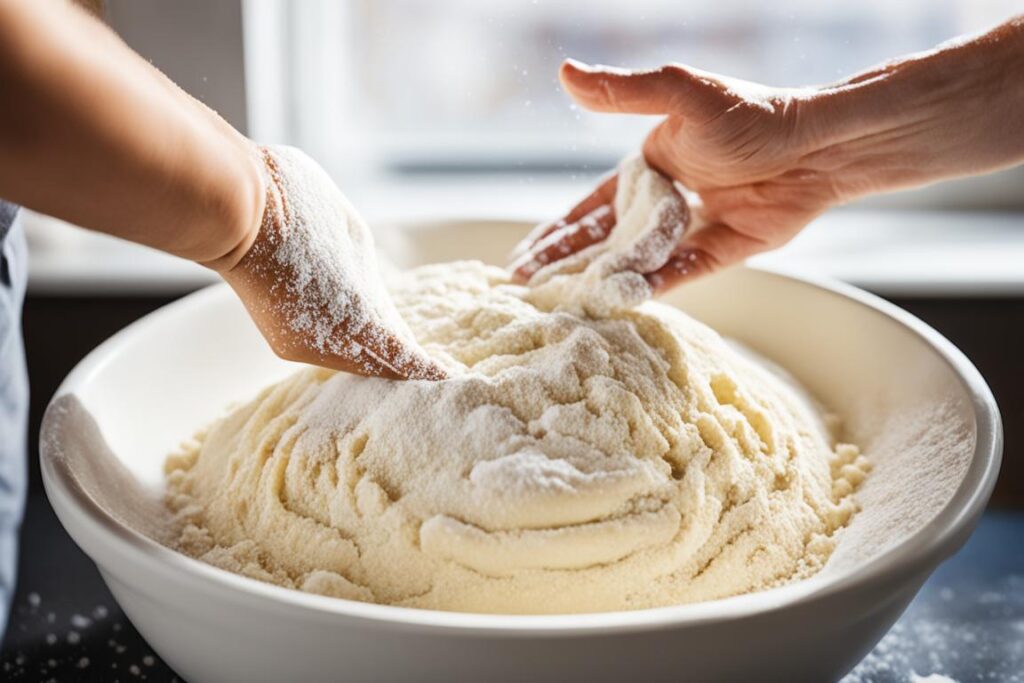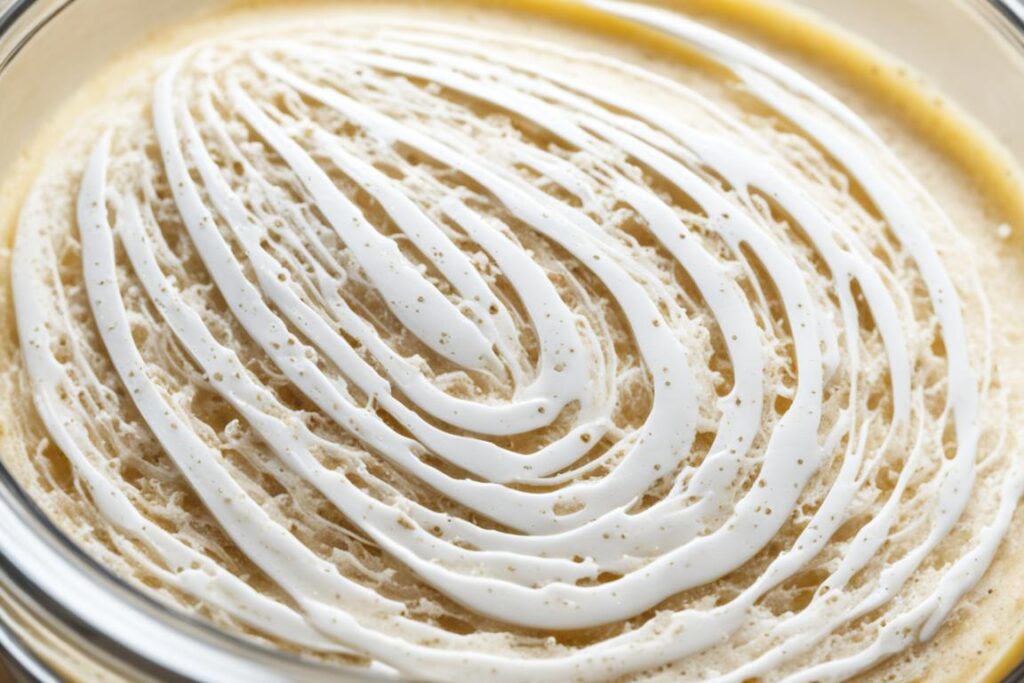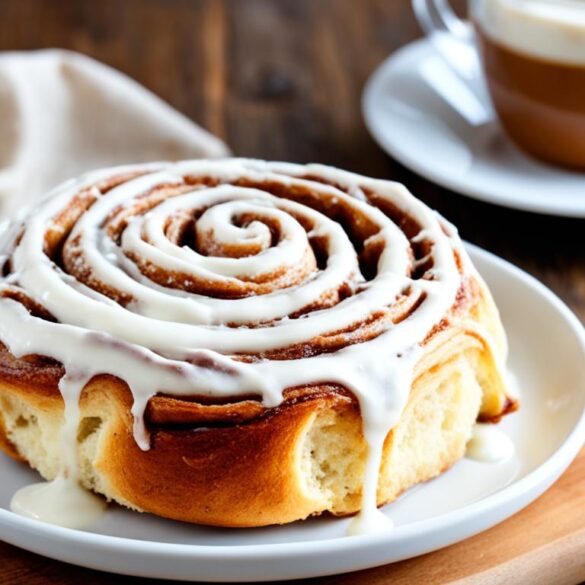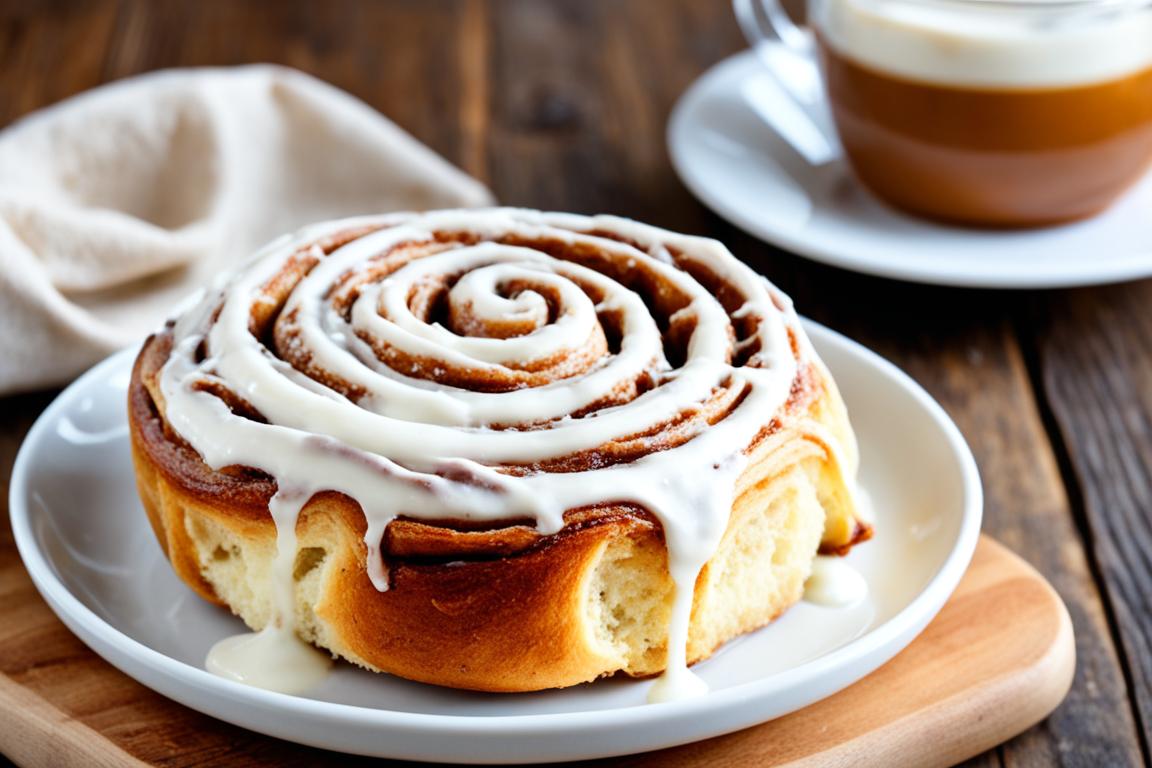Imagine the aroma of freshly baked sourdough cinnamon rolls filling your kitchen. It’s like a warm hug for your senses. These rolls are homemade, made with love and the unique taste of sourdough. They blend traditional breakfast treats with the art of sourdough baking. Each roll is a mix of comfort and sophistication.
For those who love slow food and the magic of fermentation, making breakfast pastries at home is an art. These homemade rolls are more than a tasty breakfast. They show the hard work and patience needed to master sourdough. Join us as we explore the secrets of these tasty treats. Let’s make your sourdough pastry journey rewarding.
Key Takeaways
- Experience the unique flavor fusion of sourdough and cinnamon in a homemade pastry.
- Discover the value of patiently fermented dough for a superior roll texture.
- Learn the importance of handcrafting breakfast pastries for a personalized touch.
- Uncover the joy of transforming simple ingredients into exquisite sourdough cinnamon rolls.
- Understand the dedication behind the art of sourdough for an unparalleled baking experience.
Why Sourdough Cinnamon Rolls are a Superior Choice
Making sourdough cinnamon rolls boosts their flavor and nutrition. The special way they are made adds several good qualities. These rolls are different from traditional ones.
The Benefits of Fermented Dough
Fermented dough is key to sourdough cinnamon rolls’ benefits. It uses wild yeasts and bacteria from the air, so no commercial yeast is needed. This makes the dough rise and gives it a rich flavor.
The slow fermentation process also breaks down gluten and sugars. This makes the rolls light and fluffy. It’s a big part of yeast-free baking.
Naturally Leavened for Better Digestion
The way sourdough bakes these cinnamon rolls makes them easier to digest. The fermentation breaks down some gluten, helping your stomach. This is great for people who can’t handle regular baked goods well.
It’s why more health-aware people are choosing these rolls. They are nutritious and easier on the stomach.
Comparing Yeast-Free Baking to Traditional Methods
Yeast-free baking with sourdough cinnamon rolls offers health and taste benefits. Regular yeast baking can be hard on some stomachs. But sourdough is softer, airier, and easier to digest.
It also brings out the real flavors of the ingredients. This gives a gourmet taste that’s not common in regular baked goods.
Choosing sourdough cinnamon rolls improves your baking and helps your digestion. It’s all thanks to fermented dough and natural leavening.
The Secrets Behind Perfect Sourdough Bread
Making the perfect loaf of sourdough bread is both an art and a science. It’s all about finding the right balance. The key is in natural leavening, which affects the taste, texture, and nutrition of the bread. Learning about sourdough can turn simple bread into a true work of art.
Time, temperature, and hydration are key to making great sourdough. Each one is vital for the bread’s success:
- Time: Sourdough takes time to ferment. This slow process creates a deep flavor and a light texture. It sets sourdough bread apart from quick breads.
- Temperature: The right temperature is crucial for fermentation. If it’s too cold, the bread ferments too slowly. If it’s too warm, it can ferment too much, making the taste bad.
- Hydration: The ratio of water to flour changes the dough’s feel, gluten strength, and the bread’s crumb. Getting the hydration right is key to a great-tasting and textured bread.
By controlling these factors, bakers can bring out the best in natural leavening. This leads to sourdough bread that’s not just tasty but also shows the skill of traditional baking. The secret is in the details and the care put into each step of the sourdough process.
Mastering the Art of Cinnamon Swirl Perfection
The secret to a tasty homemade roll is its cinnamon swirl. It requires precision and passion. Getting the swirl right means great taste in every bite. We’ll share tips for making the best cinnamon swirl in your rolls.
Achieving the Right Ratio of Cinnamon to Sugar
It’s key to balance cinnamon and sugar for a great cinnamon swirl. A 1:2 ratio of cinnamon to sugar is usually good. But, you can change it to suit your taste or how sweet you like things.
Rolling Techniques for a Flawless Spiral
For a standout cinnamon swirl, roll out the dough into a rectangle. Make sure it’s even in thickness. Then, spread cinnamon sugar all over, leaving a bit of room at the edges.
Start rolling from one edge, pulling it tight. This way, you get a clear spiral. It makes your rolls look and taste amazing.
Ensuring Even Distribution of the Cinnamon Filling
Uneven cinnamon filling can ruin your rolls. To fix this, press the cinnamon-sugar mix into the dough after spreading it. This makes sure it sticks to the dough and stays even when you slice and bake them.
Step-by-Step Guide to Making Sourdough Cinnamon Rolls
Start a fun baking journey that mixes old-school methods with a dash of artisan flair. We’ll guide you through making sourdough cinnamon rolls. You’ll learn how a strong sourdough starter and patience in the fermentation process are key.
Preparing Your Sourdough Starter
First, get your sourdough starter ready. A lively starter is vital for good fermentation and adds a special flavor to your rolls. Make sure it’s well-fed before mixing the dough.
Mixing and Kneading the Brioche Dough
For tender, rich brioche dough, mix your sourdough starter with quality flour, sugar, eggs, and butter. Kneading is crucial; take your time. It helps develop the gluten, which makes the dough stretchy and light.
The Fermentation Process: Patience Leads to Flavor
The magic happens during fermentation. Let your dough ferment slowly at a steady temperature. This slow rise brings out complex flavors and textures in your rolls. It makes them easier to digest and tastier.
Baking to Golden-Brown Perfection
Once the dough has grown, roll it out and cover it with cinnamon sugar. Shape it into rolls and put them in a pan. Let them proof again before baking in a hot oven until they’re golden and smell amazing.

Customizing Your Sourdough Cinnamon Rolls
One of the joys of baking your own sourdough cinnamon rolls is adding a personal touch. This makes them go from just delicious to uniquely spectacular. You can spice up your next brunch or try new flavors. The options for customizing these breakfast treats are endless.
Customizing your sourdough cinnamon rolls can mean trying different fillings or decadent toppings. Each change can make the flavor better and give these breakfast favorites a unique twist. Here are some ideas to get you started:
- Explore Different Fillings: Classic cinnamon is always good, but why not add cardamom, nutmeg, or caramel and sea salt for something new?
- Luxurious Toppings: After baking, try vanilla bean icing, maple syrup glaze, or crunchy pecans for more flavor and texture.
- Sticky Buns Variation: For fans of sticky buns, a heavy honeycomb topping with cinnamon turns your rolls into gooey, pull-apart treats perfect for any event.
Think about adding seasonal fruits or a thin slice of apple or pear before rolling. This adds freshness and a hint of sweetness that goes well with the dough’s rich taste.
Remember, the best thing about homemade sourdough cinnamon rolls is making them your own. Try different fillings, toppings, and glazes to make each batch special. This is great for family breakfasts or fancy brunches with friends.
Sourdough Cinnamon Rolls: Tips and Tricks for Beginners
Starting to bake sourdough cinnamon rolls is both thrilling and a bit scary. We’ll cover important tips for keeping your sourdough starter healthy, adjusting dough hydration, and fixing common sourdough problems. This will help make sure your baking journey is successful from the start.

How to Maintain a Healthy Sourdough Starter
A healthy sourdough starter is key to great sourdough cinnamon rolls. For beginners, it’s important to feed your starter regularly. Use equal parts of flour and water to keep it alive and healthy. If you see strange smells or colors, it might be time to start over.
Adjusting Hydration Levels in Your Dough
Hydration levels greatly affect your sourdough cinnamon rolls’ texture. More hydration can make the rolls light and airy but can be harder to work with. If you live in a dry area, adding more hydration might help get the dough right. It’s about finding what works for you.
Troubleshooting Common Sourdough Issues
- Starter not rising? Make sure it’s in a warm, draft-free place and use fresh, quality flour.
- Dough too sticky? Try adjusting the flour ratio or folding the dough more during the initial mixing.
- Rolls not fluffy? This could mean they weren’t given enough time to rise. Give them more time before baking.
Mastering these basics will help you make delicious sourdough cinnamon rolls that everyone will love. Remember, patience and practice are key when you’re starting with sourdough baking!
Ideas for Serving and Enjoying Homemade Rolls
Wow your family and guests with creative ways to serve and enjoy sourdough cinnamon rolls. These tasty breakfast pastries are not only delicious but also versatile. They make every bite a joyful experience. Here are some inspiring suggestions to elevate your breakfast or brunch table.
- Pair with artisan coffee or a well-steamed latte for a warm, cozy breakfast. The rich flavors of the coffee complement the subtle sourness of the sourdough cinnamon rolls. This enhances the overall taste experience.
- Offer a side of fresh fruit compote or berry sauce to add a refreshing contrast to the sweet and spiced flavors. This combination not only looks vibrant but also balances the palate.
- Serve as a dessert after a light meal, perhaps with a scoop of vanilla bean ice cream or a drizzle of caramel sauce for those who enjoy a decadent treat.
- Arrange a platter of mini sourdough cinnamon rolls as a part of a larger brunch spread. Invite guests to indulge in a bite-sized delight.
Sourdough cinnamon rolls can also be adapted to fit various dietary preferences. This makes them an excellent choice for gatherings with diverse dietary needs. Here’s how you can keep everyone happy:
- Provide gluten-free and vegan options by modifying the ingredients to cater to guests with specific dietary restrictions. This ensures that no one misses out on enjoying these wonderful breakfast pastries.
- Think about adding nuts like pecans or walnuts for an added crunch and nutritional boost.
Don’t forget the leftover sourdough cinnamon rolls! They can be easily reheated for a quick snack or even repurposed into delicious treats like bread pudding or French toast. This brings new life to your leftovers.
With these serving suggestions, you can turn any occasion into a special one. Embrace the versatility of sourdough cinnamon rolls and keep experimenting with different flavors and pairings to find your perfect match. Whether for a lazy weekend morning, a festive brunch, or a comforting evening snack, these rolls promise satisfaction to the last crumb.
Conclusion
Starting to make homemade rolls, like sourdough cinnamon rolls, is more than a cooking project. It’s a craft that requires patience and skill. This guide has shown us the steps from fermenting dough to getting the cinnamon swirl just right. The smell of warm sticky buns coming from the oven is a reward for all the hard work.
Sourdough adds a unique tang to traditional sweet treats. Its natural process gives a flavor unlike any other. Even with challenges along the way, the end result is worth it. These rolls are not just food; they’re an experience with layers of taste.
Sharing homemade sourdough cinnamon rolls, whether on a lazy Sunday or at a family event, is special. The aroma of these rolls fills your home with joy. Each roll is a piece of your effort, a mix of science and art. We hope this guide inspires you to explore sourdough baking and enjoy its unique flavors.
FAQ
What makes sourdough cinnamon rolls different from regular cinnamon rolls?
Sourdough cinnamon rolls have a tangy flavor from fermented dough. This makes them healthier and tastes different from regular cinnamon rolls. They use a natural starter instead of commercial yeast.
Why is yeast-free baking with sourdough considered healthier?
Baking with sourdough is healthier because it breaks down gluten and phytic acid. This makes the bread easier to digest and more nutritious. It also helps keep your gut healthy.
How does the fermentation process affect the taste of sourdough bread?
Fermentation in sourdough bread makes it taste richer and tangy. This is because of the lactic acid produced by bacteria. It gives sourdough a unique flavor that’s better than quick-acting yeast bread.
How do you achieve the perfect cinnamon to sugar ratio for sourdough cinnamon rolls?
For the best cinnamon to sugar mix, use 1 tablespoon of cinnamon for every 1/4 cup of sugar. You can adjust this to make the cinnamon filling as sweet or strong as you like.
Can you share some tips for rolling the perfect cinnamon swirl?
For a great cinnamon swirl, roll the dough into a rectangle. Spread the filling evenly, leaving a border. Roll it up tightly and cut into equal pieces for a beautiful spiral.
What are the steps to prepare a sourdough starter for cinnamon rolls?
Start by mixing flour and water in a jar and leave it out. Feed it flour and water daily until it’s active and smells tangy. It’s ready when it doubles in size in 4 to 6 hours.
How long should sourdough cinnamon rolls ferment to develop flavor?
Let sourdough cinnamon rolls ferment for a few hours to overnight. This depends on the temperature and starter activity. Longer fermentation makes the rolls taste better and have a great texture.
How can you customize sourdough cinnamon rolls?
Try different fillings like nuts, fruit preserves, or spices in your sourdough cinnamon rolls. Add lemon zest, cardamom, or nutmeg for a twist. You can also top them with glazes, cream cheese frosting, or caramel pecan topping.
What are some serving suggestions for sourdough cinnamon rolls?
Serve sourdough cinnamon rolls for breakfast, as a snack, or dessert. Enjoy them with coffee, tea, milk, or whipped cream. They’re perfect for many occasions.
How do you store leftover sourdough cinnamon rolls?
Keep leftover rolls in an airtight container at room temperature for 2 days or refrigerate for a week. Reheat them in the oven or microwave until warm and the icing is melted. You can also freeze them for longer storage.

Sourdough Cinnamon Rolls
Equipment
- Mixing Bowl
- Rolling Pin
- Baking Pan
Ingredients
Dough Ingredients
- 1 cup Sourdough Starter Well-fed and active
- 3 cups All-Purpose Flour
- 1/4 cup Sugar
- 1/2 cup Butter Melted
- 2 large Eggs
Filling Ingredients
- 1 cup Brown Sugar
- 2 tablespoons Ground Cinnamon
- 1/4 cup Chopped Nuts Optional
Instructions
- Prepare your sourdough starter and ensure it is active.
- In a mixing bowl, combine the sourdough starter, flour, sugar, melted butter, and eggs. Mix until a dough forms.
- Knead the dough on a floured surface until smooth, about 10 minutes.
- Let the dough rise in a warm place until doubled in size, about 1-2 hours.
- Roll out the dough into a rectangle and spread the brown sugar and cinnamon mixture evenly over the surface.
- Roll the dough tightly from one edge to the other and slice into rolls.
- Place the rolls in a greased baking pan and let them proof for another hour.
- Bake in a preheated oven at 350°F (175°C) for 25 minutes or until golden brown.

